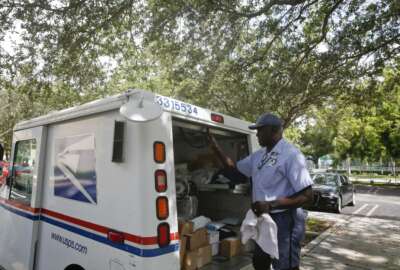
Democratic lawmakers wary of Treasury’s conditions for USPS $10B emergency loan
Rep. Gerry Connolly (D-Va.) said that before the COVID-19 pandemic, USPS and Treasury had negotiated lifting the Postal Service’s borrowing cap. But in return, he...
Before the coronavirus, the Postal Service warned Congress it would run out of cash by 2024.
But a precipitous drop in mail volume during the pandemic has sped up that timeline, and the agency could run out of money as early as June.
In response to this financial emergency, President Donald Trump signed into law a $2 trillion emergency funding bill that would allow USPS to borrow another $10 billion from the Treasury Department.
Now House and Senate Democrats have pushed for the Treasury Department to disburse those loan payments to USPS as soon as possible.
USPS officials have told congressional committees that the agency may lose up to $12.6 billion in mail revenue this year because of the coronavirus pandemic.
As of last December, the agency had $8.4 billion in cash on hand.
In a letter to Treasury Secretary Steve Mnuchin, Sens. Tom Carper (D-Del.) and Gary Peters (D-Mich.) as well as Reps. Gerry Connolly (D-Va.) and Carolyn Maloney (D-N.Y.) said USPS has also seen increased spending to sanitize facilities, purchase protective equipment and train staff on new procedures.
“We cannot afford to lose this vital infrastructure at a time when it is most needed to continue delivering prescription drugs, critical packages to households and businesses, coronavirus-related information, vote-by-mail materials, testing kits, medical equipment, and eventually vaccines across this nation,” the lawmakers wrote.
The letter requests Treasury provide the terms and conditions of the $10 billion loan “including information about any postal policy and/or operational provisions Treasury intends to improperly include as a condition of borrowing.”
In an interview April 2, Connolly said that before the COVID-19 pandemic, USPS and Treasury had negotiated lifting the Postal Service’s borrowing cap. But in return, he said Treasury asked for greater oversight of USPS.
“Essentially, the Treasury Department insisted that management responsibilities be transferred from the Postal Service itself, which is a quasi-independent agency, to the Treasury Department. That was an unacceptable condition, and it’s a step we fear toward trying to privatize the Postal Service,” Connolly said.
The letter reminds Treasury that the USPS Board of Governors has the exclusive authority to appoint or remove the postmaster general or “direct and control the expenditures and review the practices and policies of the Postal Service.”
“We expect the Treasury Department to fully comply with federal statutes and refrain from setting any conditions that would infringe on the Postal Service’s statutory authorities. We cannot afford to compromise this lifeline for seniors, rural areas, and all Americans.”
The $2 trillion spending bill required the terms of the $10 billion loan be, as the letter states, “mutually agreed upon by the [Treasury] Secretary and the Postal Service.”
The Postal Service receives no annual appropriations from Congress and operates on its own revenue.
While a Treasury-led postal task force in December 2018 recognized that the Postal Service faces significant long-term business challenges, the Trump administration has resisted efforts to fund the agency’s recovery.
Margaret Weichert, the former deputy director for management at the Office of Management and Budget, told a Senate committee last year that the Postal Service should continue to maintain itself “as a fully funded capability.”
In a sweeping government reform plan released in June 2018, the White House also proposed restricting and privatizing the Postal Service, but the administration has since walked back that plan.
Lawmakers push for USPS funding in 4th spending bill
Before the president signed the $2 trillion emergency spending bill, House Democrats pressed for giving the Postal Service additional funding in a future emergency spending bill aimed at infrastructure support.
A House-version the emergency spending bill would have set aside $25 billion for USPS until September 2022, and would have forgiven the Postal Service’s $11 billion debt to the Treasury Department and allow the agency to borrow another $15 billion.
The bill would have also eliminated a $3 billion annual borrowing limit for this line of credit from Treasury.
Connolly said House lawmakers will continue to push for further financial relief of the Postal Service in a fourth round of emerging spending when the House and Senate reconvene April 20.
In the meantime, some lawmakers have also made their priorities known.
Last Tuesday, Rep. Joe Neguse (D-Colo.) introduced a bill that would also provide USPS with a one-time emergency appropriation of $25 billion.
“As this public health emergency worsens, our frontline postal workers remain vulnerable to the coronavirus and our post offices require immediate support to maintain on-time and consistent deliveries for customers who are quarantining or vulnerable and rely on mail for essential supplies and food,” Neguse said in a statement.
Copyright © 2025 Federal News Network. All rights reserved. This website is not intended for users located within the European Economic Area.
Jory Heckman is a reporter at Federal News Network covering U.S. Postal Service, IRS, big data and technology issues.
Follow @jheckmanWFED
Related Stories

USPS seeks to hire retired employees, temporary workers as coronavirus takes toll on workforce




